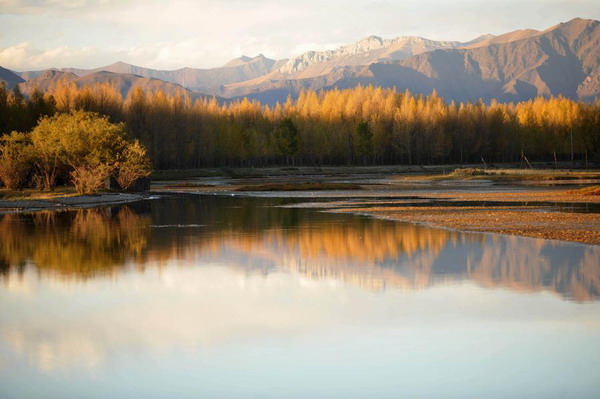 |
|
Photo taken on Oct 7, 2015 shows the autumn scenery of the Lhasa River in Southwest China's Tibet autonomous region.[Photo/Xinhua] |
With an average altitude of about 4,000 meters, the Qinghai-Tibet Plateau in southwestern China is a unique geographical region. It is the source of the major rivers of China, South Asia and Southeast Asia, home to important species and biological diversity, the adjuster of climate change and a great provider of ecological security. Yet all these traits, along with its cold temperature, make the ecological environment of the plateau extremely vulnerable.
The ecological environment of the plateau has improved since the 1980s despite increasing human activities. Since the 1990s, the plateau's vegetation and ecological functions have grown further, and forested areas increased.
The plateau's biological diversity has been well protected, according to data from local authorities. The Tibet autonomous region has established 47 natural conservation areas, which cover 34 percent of the region and is cumulatively the largest in the country in terms of acreage. The conservation areas in the region are protecting 125 rare wild animals listed into State protection, as well as help the ecosystem function naturally and ensure the sustainable use of biological resources.
The number of yaks on the plateau has increased from 15,000 in 2003 to about 40,000 today. Also, the numbers of Tibetan antelopes and Equus kiang (wild asses) have increased from 80,000 and 50,000 at the beginning of this century to about 150,000 and 90,000. And about 80 percent of the world's black-nested cranes are found at the National Natural Conservation Area in the Yarlung Zangbo River valley.
Hence, one can safely say that the plateau's natural conservation areas provide ecological security, which is important for human survival and harmonious social development.
The plateau suffered some ecological and environmental degradation before the launching of reform and opening-up. Not surprisingly, climate change is already having an impact on the plateau's ecology.
The central government has always paid special attention to ecological construction and protection work on the plateau. The ecological protection plans for the three major sources of rivers on the plateau, drawn up by the Tibet autonomous region, Qinghai province and central authorities, are already showing results.
The overall population of the Qinghai-Tibet Plateau has increased from 2.76 million in 1952 to 7.38 million. The population of the Tibet autonomous region has risen from 1.23 million before the peaceful liberation of Tibet to 3.08 million, and life expectancy has increased from 36 years to about 70 years. The per capita income of farmers and herdsmen's increased from 178 yuan ($28) in 1978 to 6,500 yuan in 2013.
In 2010, China launched pilot subsidy and reward projects for the protection of grasslands in Tibet, which has greatly restored the ecology. The year 2013 saw the establishment of the High-cold Region Observation and Research Network for long-term studies and monitoring of the ecology and environment of the Qinghai-Tibetan Plateau.
But climate change continues to greatly influence the plateau's ecology and environment, although it has also had some "positive" but unbalanced influence. And the implementation of the ecological protection and construction projects has curbed the degradation of the ecosystem in some parts of the plateau.
The ecological protection project for the plateau, however, is a long-term task, which requires research and practice, as well as the participation of the entire society. Under the central leadership, and with help from governments at all levels and members of all ethnic groups on the plateau, especially Tibetan people, the ecological project will make the plateau a more beautiful and prosperous place.
Zhang Xianzhou is a researcher at the Institute of Geographic Sciences and Natural Resource Research, Chinese Academy of Sciences, and Wang Shiping and Piao Shilong are researchers at the Institute of Tibetan Plateau Research, Chinese Academy of Sciences.

I’ve lived in China for quite a considerable time including my graduate school years, travelled and worked in a few cities and still choose my destination taking into consideration the density of smog or PM2.5 particulate matter in the region.